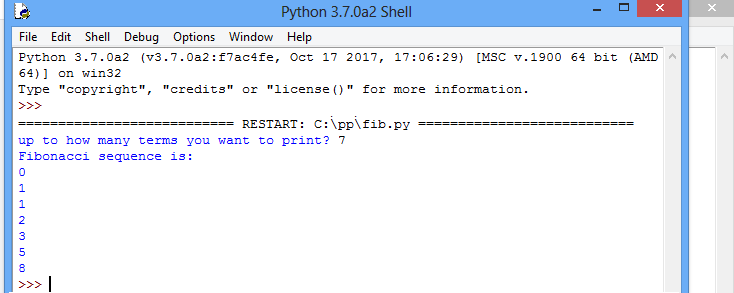

- #Python fibonacci recursive how to#
- #Python fibonacci recursive generator#
- #Python fibonacci recursive software#
- #Python fibonacci recursive code#
The original program takes an integer and provides its Fibonacci using recursion. On solving the above recursive equation we get the upper bound of Fibonacci as but this. The sequence comes up naturally in many problems and has a nice recursive definition. This also includes the constant time to perform the previous addition. The Fibonacci sequence is a pretty famous sequence of integer numbers. What this means is, the time taken to calculate fib (n) is equal to the sum of time taken to calculate fib (n-1) and fib (n-2). Fibonacci series is one of the most common algorithms studied by beginner programmers, as it is a way to implement the recursion method in any of the most.


We will create both recursive and non-recursive function in.
#Python fibonacci recursive how to#
This prints all numbers in ONE line, separated by spaces.I'm working with a basic Python MIT free courseware and I have run into a wall with a recursion exercise. We know that the recursive equation for Fibonacci is + +. In this example we will see how to build fibonacci series using Python programming language. What I really want to know is why all of a sudden iteration became faster and recursion became slower. So, having fib defined, the program would be something like (sorry, just looping is boring, here's some more cool python stuff: list comprehensions) fib_n = int(input("Fib number?")) It looks as if you were thinking of doing something recursive, but you failed to actually do the recursive part, i.e. Syntax: def func (): <- (recursive call) func () - Example 1: A Fibonacci sequence is the integer sequence of 0, 1, 1, 2, 3, 5, 8. Example 3 (n 30) Enter the last element of Fibonacci sequence: 30 Fibonacci iteration: Fibonacci sequence (element at index 30) 832040 Time: 4 ms Fibonacci recursion: Fibonacci sequence (element at index 30) 832040 Time: 15 ms. The advantage of recursion is that the program becomes expressive. The second way tries to reduce the function calls in the recursion. (see this amazing question on SO for details about python decorators :) In this tutorial, we present you two ways to compute Fibonacci series using Recursion in Python. However, the decorator implementation is just quick and dirty, don't let it into production.
#Python fibonacci recursive code#
So, this solution would outperform all the rest. Generate the Fibonacci sequence using a recursive algorithm Optimize the recursive Fibonacci algorithm using memoization Generate the Fibonacci sequence using an iterative algorithm Download Sample Code (.zip) 2.4 KB Download Course Slides (.pdf) 9. All other terms are obtained by adding the preceding two terms.

Exploring the infrastructure and code behind modern edge functions. A Fibonacci sequence is the integer sequence of 0, 1, 1, 2, 3, 5, 8.
#Python fibonacci recursive software#
The Overflow Blog The Overflow 185: The hardest part of software is requirements. This time each fibbonacci number calculated exactly once, and than stored. python python-3.x recursion fibonacci-sequence or ask your own question. #added for demonstration purposes only - not really neededĬall_count = 0 #added for demonstration purposes only - not really needed One more time, recursive with memoization: def memoize(func):
#Python fibonacci recursive generator#
Note that generator solution outperforms the non-recursive (and non-recursive outperforms recursive, if memoization is not applied to recursive solution)


 0 kommentar(er)
0 kommentar(er)
